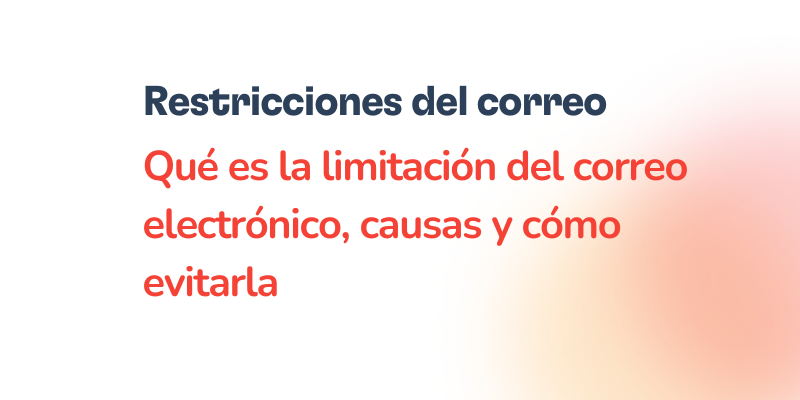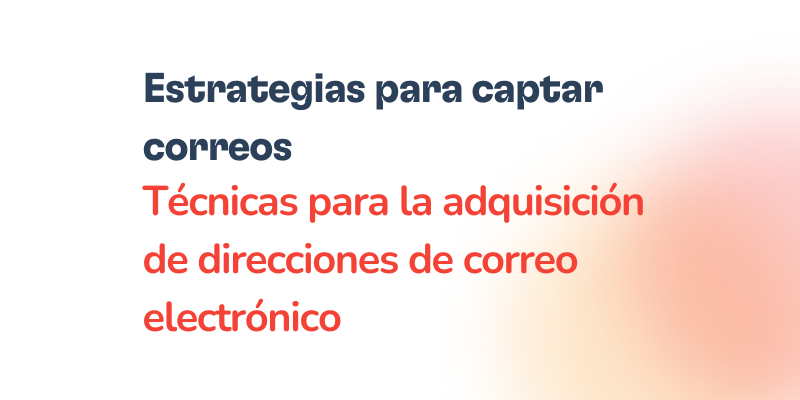Email throttling can have a dramatic effect on the success of your email marketing campaigns.
While this subject might not be as sexy as AI-driven content personalization or machine learning algorithms, understanding how emails are sent and delivered is essential if you want to make sure that your message reaches its intended recipients quickly, and with maximum effectiveness.
In this blog post, we provide an overview of the concept of email throttling and discuss some strategies for optimizing deliverability in spite of it.
In today’s digital age, email has become an indispensable tool for communication, both personal and professional. For businesses, email marketing has become a crucial aspect of their overall marketing strategy, allowing them to reach out to potential and existing customers in a cost-effective and efficient manner.
However, the success of any email marketing campaign depends heavily on whether the emails are being delivered to the intended recipients’ inboxes.
Email deliverability is the measure of how successful an email is at reaching its destination. Poor email deliverability can have serious consequences, including lost sales opportunities, damage to the sender’s reputation, and even being blacklisted by email providers.
What is email throttling?
Email throttling is a technique used by email service providers (ESPs) to limit the number of emails sent from a particular sender or IP address over a certain period of time.
The purpose of email throttling is to prevent the sender from overwhelming the recipient’s inbox and to maintain the integrity of the ESP’s email infrastructure. By implementing email throttling, ESPs can ensure that their network resources are used efficiently and that their email sending practices are compliant with industry standards and regulations.
Email throttling can affect a sender’s ability to deliver emails promptly, but it can also help improve email deliverability and reduce the likelihood of emails being marked as spam or blocked by email filters.
How does email throttling work?
Email throttling works by controlling the rate at which emails are sent from a particular sender or IP address. The sending rate is usually limited to a certain number of emails per hour or per day, depending on the policies of the ESP. The exact sending limits can vary depending on the sender’s reputation, the recipient’s email service provider, and other factors.
When a sender reaches their sending limit, the ESP will typically hold any additional emails in a queue until the next sending period. This can cause delays in the delivery of emails, but it helps ensure that the sender is not overwhelming the recipient’s inbox or triggering spam filters.
Email throttling can also involve ramping up the sending rate gradually over time. This is known as “ramp-up” throttling and is often used for new senders or senders with a poor reputation. The ESP will start by allowing a small number of emails to be sent and gradually increase the sending limit over several days or weeks, as long as the sender’s deliverability remains good.
How does email throttling affect email marketing?
Email throttling can significantly impact the effectiveness of your email marketing campaigns. Here are some ways that email throttling can affect email marketing:
✅ Delivery delays
Email throttling can cause delays in email delivery, which can result in your subscribers receiving your emails later than expected. This can be frustrating for your subscribers and may result in lower engagement rates.
✅ Lower email deliverability
If your emails are frequently throttled, it can harm your sender reputation and result in lower email deliverability. This can make it more difficult to reach your subscribers’ inboxes and can negatively impact the effectiveness of your email marketing campaigns.
✅ Inconsistent email performance
Email throttling can cause inconsistent email performance, making it difficult to predict the success of your email campaigns. You may experience fluctuations in email open rates, click-through rates, and other metrics, which can make it challenging to optimize your email marketing strategy.
✅ Difficulty reaching new subscribers
If you have a new IP address or domain, email throttling can make it challenging to reach new subscribers. This is because mailbox providers (MBPs) and email service providers (ESPs) may be more cautious when delivering emails from new senders.
Throttling in mailing systems (ESP)
Throttling in mailing systems, also known as Email Service Providers (ESPs), is a technique used to control the sending rate of emails from a particular sender or IP address. ESPs implement throttling to prevent senders from overwhelming their email infrastructure, which can lead to delivery delays, lower email deliverability, and even blacklisting.
There are several ways that ESPs can implement throttling in their mailing systems. One common method is to limit the number of emails that can be sent in a given time period, such as per hour or per day. The sending limit can be set based on various factors, including the sender’s reputation, the recipient’s email service provider, and the type of email being sent.
Another way that ESPs can implement throttling is by gradually increasing the sending rate over time, also known as ramp-up throttling. This method is commonly used for new senders or senders with a poor reputation. The ESP will start by allowing a small number of emails to be sent and gradually increase the sending limit over several days or weeks, as long as the sender’s deliverability remains good.
Throttling can also be implemented on a recipient basis. This means that ESPs can limit the number of emails sent to a particular email address or domain to prevent overloading the recipient’s inbox and triggering spam filters.
Throttling in email providers (MBP)
Throttling in email providers, also known as Mailbox Providers (MBPs), is a technique used to control the rate at which emails are received by their email servers. MBPs implement throttling to prevent senders from overwhelming their email servers, which can lead to delivery delays, lower email deliverability, and even blacklisting.
There are several ways that MBPs can implement throttling in their email systems. One common method is to limit the number of connections that can be established from a particular IP address in a given time period. This means that senders can only establish a limited number of connections with the MBP’s email servers at any given time. The exact limit can vary depending on the MBP’s policies and the sender’s reputation.
Another way that MBPs can implement throttling is by limiting the number of emails that can be received from a particular sender or IP address in a given time period. This is known as “recipient throttling” and helps prevent a sender from overwhelming the MBP’s email servers with too many emails too quickly.
MBPs can also implement throttling based on the type of email being received. For example, MBPs may give priority to emails that are more likely to be important or time-sensitive, such as emails from known contacts or emails marked as “urgent.”
How do you know if your emails are being throttled?
It can be difficult to know if your emails are being throttled, as email throttling is typically implemented on the email service provider (ESP) or mailbox provider (MBP) side and is not something that is visible to the sender.
However, there are some signs that may indicate that your emails are being throttled. One common sign is a sudden decrease in email delivery rates or open rates, particularly if you have not made any significant changes to your email sending practices. This may indicate that your emails are being held in a queue or are being delivered at a slower rate than usual.
Another sign of email throttling is if you receive bounce-back messages from the recipient’s email service provider indicating that your emails were not delivered due to a temporary error or that the mailbox is full. This may indicate that your emails are being held in a queue and delivered at a slower rate than usual.
If you suspect that your emails are being throttled, you can try contacting your email service provider or mailbox provider to ask if they have implemented any throttling measures.
You can also review your email sending practices to ensure that you are following best practices for email deliverability, such as using a consistent sending schedule, maintaining a good sender reputation, and avoiding spam triggers.
5 causes of email throttling
Sending too many emails too quickly
Email service providers (ESPs) and mailbox providers (MBPs) often implement throttling to prevent senders from overloading their email infrastructure. If you send too many emails too quickly, it can trigger throttling, which can result in delivery delays, lower email deliverability, and even blacklisting.
Poor sender reputation
Your sender reputation is a crucial factor in email deliverability. If your emails have a high bounce rate, are marked as spam, or are frequently reported as unwanted, it can harm your sender reputation and trigger throttling by ESPs or MBPs.
Using a new IP address or domain
If you’re a new sender or have recently switched to a new IP address or domain, you may be subject to ramp-up throttling, where ESPs gradually increase your sending limit over several days or weeks. This is to ensure that your emails are sent in a responsible and compliant manner.
Sending to inactive or unengaged subscribers
Sending emails to inactive or unengaged subscribers can harm your sender reputation and trigger throttling by ESPs or MBPs. It’s important to regularly clean your email list and remove inactive subscribers to improve email deliverability.
Sending emails outside of normal business hours
Some ESPs and MBPs may implement throttling during off-peak hours or weekends to ensure that their email infrastructure is not overwhelmed. If you frequently send emails outside of normal business hours, it can trigger throttling and harm your email deliverability.
How to prevent email throttling
1. Warming up a new IP is a crucial step in preventing email throttling and establishing a positive sending reputation with mailbox providers (MBPs) and email service providers (ESPs).
The best way is to use email deliverability services like Warmy.io.
Warmy quickly and professionally warming up your email, improve domain reputation and improve your email deliverability. Everything is automated.
Warmy quickly and professionally warming up your email, improve domain reputation and improve your email deliverability. Everything is automated.

2. Maintain a good sender reputation: Your sender reputation is critical to email deliverability.
Warming up a domain will ensure a gradual building of domain reputation.
Follow best practices for email marketing, such as sending relevant and engaging content, using a clear and recognizable sender name and email address, avoiding spam trigger words, and regularly cleaning your email list.
3. Authenticate your emails: Use email authentication protocols such as SPF, DKIM, and DMARC to verify your email sending domain and improve your email deliverability. Email authentication can help prevent your emails from being marked as spam or rejected by mailbox providers (MBPs).
4. Segment and target your email list: Sending targeted and personalized emails to specific segments of your email list can improve engagement and reduce the risk of triggering throttling. By sending relevant and targeted content, you can improve the overall quality of your email campaigns and avoid sending too many irrelevant emails.
5. Follow ESP guidelines: Each ESP has their own guidelines and best practices for email marketing. Follow these guidelines to ensure that your email campaigns are compliant and avoid triggering throttling or other delivery issues.
Conclusion
Email throttling can be a difficult obstacle to overcome, but with the right strategies, marketers can find success. Ultimately, understanding how your emails are being received and ensuring that best practices are followed to keep your messages from being unintentionally sent too frequently – is key for campaign success.
Careful monitoring of any delayed delivery is also essential because it can indicate issues with email throttling. It’s important to remember that your goal should be to provide useful, valuable content via email – not just send lots of them out in quick succession.
By understanding what email throttling is and its potential impact on your marketing efforts, you will have the necessary steps outlined in order to ensure optimal results with your campaigns.
Finally, one last suggestion – be tactical in your approach when optimizing email campaigns and incorporate effective strategies such as segmentation or personalization – these kinds of tactics can help overcome any lazy loading delays caused by throttling and maintain a healthy delivery rate overall.








![Text on a white background reads: SMTP Error 450 4.0.0 How to Resolve [SOLVED], with emphasis on smtp error 450 4.0.0 and How to Resolve [SOLVED] in red font.](https://warmy-blog-wordpress-bucket.s3.amazonaws.com/wp-content/uploads/2025/11/19084901/SMTP450-400.webp)



